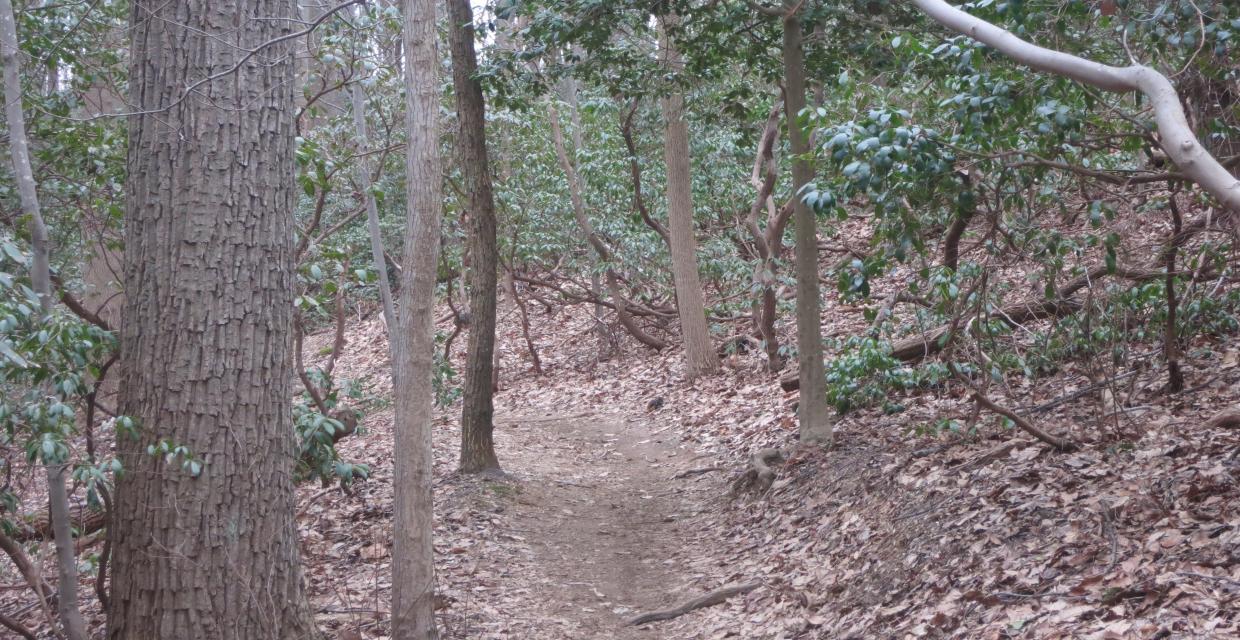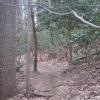Hartshorne Woods Park


Park Overview:
With multi-use trails this is a popular destination for bicyclists and hikers. Visitors can view the Navesink River on a site that is among the highest elevations along the Atlantic Coast.
Park Description:
A unit of the Monmouth County park system, Hartshorne Woods Park is named after Richard Hartshorne (pronounced "hart's horn"), the first European settler in the area, who purchased the land from the Native Americans. About two thirds of the present acres were acquired by the county in 1974. The Rocky Point section, which had been the site of the Highlands Army Air Defense Command since 1940, was declared surplus property by the Department of Defense in 1979 and acquired by the county as an addition to the park. The area was restored and opened to the public in the early 1990s.
The park rises from sea level at the Shrewsbury and Navesink rivers to 274 feet above sea level. Located along an otherwise flat coastal plain, Hartshorne Woods sits astride a line of low but steep-sided hills. These hills mark the edge of a cuesta - a geomorphic landscape feature formed from sandstone layers that are slightly tilted. These layers, composed of quartz and other particles, were cemented together by iron oxides, and were thus more resistant to erosion than the unconsolidated sediments which once overlayed them. The forest is more similar to New Jersey's northern highlands than to the rest of Monmouth County. The hills support forests of oak, hickory, and tulip trees, with an understory of American holly and mountain laurel.
Trails Overview:
Trailheads and parking are at the Buttermilk Valley Entrance and, some distance away, the Rocky Point Entrance. Trails range in length from 0.6 mile to 3.4 miles. Among the six or seven trails in the park all but two short ones - the Candlestick and Kings Hollow trails, both of which start at the Buttermilk Valley parking area - are multi-use trails open to hikers, runners, bicyclists, and equestrians. The trails are heavily used by bicyclists and joggers. Park regulations provide that bicyclists must yield to all other trail users; however, many trails open to bicycles are narrow, winding, "single-track" routes. Thus, hikers should be alert for approaching bicycles. Fewer bikers use nearby Huber Woods Park. Hikers must yield to equestrians.
Typical of Monmouth County parks, trails are not blazed, although they have been classified into three categories based on difficulty. Signposts at trail junctions use colored symbols to designate three classes of trails: "easy" [green circles]; "moderate" [blue squares]; and "challenging' [black diamonds]. These designations are geared primarily towards bicyclists. Thus, while trails designated with black diamonds are stated to be "challenging ... with obstructions and steep grades," most hikers will find these trails to be of no more than moderate difficulty.
Use the Web Map link on this site for a brochure and trail map. Click here for detailed descriptions hikes in the park.
Park Acreage:
794.00 acresMunicipality:
Locust, HighlandsWith multi-use trails this is a popular destination for bicyclists and hikers. Visitors can view the Navesink River on a site that is among the highest elevations along the Atlantic Coast.
A unit of the Monmouth County park system, Hartshorne Woods Park is named after Richard Hartshorne (pronounced "hart's horn"), the first European settler in the area, who purchased the land from the Native Americans. About two thirds of the present acres were acquired by the county in 1974. The Rocky Point section, which had been the site of the Highlands Army Air Defense Command since 1940,...
Park Acreage:
794.00 acresMunicipality:
Locust, HighlandsContact Information
Web Link:
Monmouth County Park SystemPhone:
(732) 872-4000Fees:
NoneDogs in park:
Not availableHike Checklist:
Whether you are going for a day hike or backpacking overnight, it is good practice to carry what we call The Hiking Essentials. These essentials will help you enjoy your outing more and will provide basic safety gear if needed. There may also be more essentials, depending on the season and your needs.
The Essentials
Hiking Shoes or Boots
Water - Two quarts per person is recommended in every season. Keep in mind that fluid loss is heightened in winter as well as summer. Don't put yourself in the position of having to end your hike early because you have run out of water.
Map - Know where you are and where you are going. Many of our hiking areas feature interconnecting network of trails. Use a waterproof/tear-resistant Tyvek Trail Conference map if available or enclose your map in a Ziplock plastic bag. If you have a mobile device, download Avenza’s free PDF Maps app and grab some GPS-enhanced Trail Conference maps (a backup Tyvek or paper version of the map is good to have just in case your batteries die or you don't have service). Check out some map-reading basics here.
Food - Snacks/lunch will keep you going as you burn energy walking or climbing. Nuts, seeds, and chocolate are favorites on the trail.
Sunscreen and insect repellent
Rain Gear and Extra Clothing - Rain happens. So does cold. Be prepared for changing weather. Avoid cotton--it traps water against your skin and is slow to dry. If you are wearing wet cotton and must return to your starting point, you risk getting chills that may lead to a dangerous hypothermia. Choose synthetic shirts, sweaters and/or vests and dress in layers for easy on and off.
Compass - A simple compass is all you need to orient you and your map to magnetic north.
Light - A flashlight or small, lightweight headlamp will be welcome gear if you find yourself still on the trail when darkness falls. Check the batteries before you start out and have extras in your pack.
First Aid Kit - Keep it simple, compact, and weatherproof. Know how to use the basic components.
Firestarter and Matches - In an emergency, you may need to keep yourself or someone else warm until help arrives. A firestarter (this could be as simple as leftover birthday candles that are kept inside a waterproof container) and matches (again, make sure to keep them in a waterproof container) could save a life.
Knife or Multi-tool - You may need to cut a piece of moleskin to put over a blister, repair a piece of broken equipment, or solve some other unexpected problem.
Emergency Numbers - Know the emergency numbers for the area you're going to and realize that in many locations--especially mountainous ones, your phone will not get reception.
Common Sense - Pay attention to your environment, your energy, and the condition of your companions. Has the weather turned rainy? Is daylight fading? Did you drink all your water? Did your companion fail to bring rain gear? Are you getting tired? Keep in mind that until you turn around you are (typically) only half-way to completing your hike--you must still get back to where you started from! (Exceptions are loop hikes.)
Check the weather forecast before you head out. Know the rules and regulations of the area.
The Leave No Trace Seven Principles
Plan Ahead and Prepare
- Know the regulations and special concerns for the area you'll visit.
- Prepare for extreme weather, hazards, and emergencies.
- Schedule your trip to avoid times of high use.
- Visit in small groups when possible. Consider splitting larger groups into smaller groups.
- Repackage food to minimize waste.
- Use a map and compass to eliminate the use of marking paint, rock cairns or flagging.
Travel and Camp on Durable Surfaces
- Durable surfaces include established trails and campsites, rock, gravel, dry grasses or snow.
- Protect riparian areas by camping at least 200 feet from lakes and streams.
- Good campsites are found, not made. Altering a site is not necessary.
- In popular areas:
- Concentrate use on existing trails and campsites.
- Walk single file in the middle of the trail, even when wet or muddy.
- Keep campsites small. Focus activity in areas where vegetation is absent.
- In pristine areas:
- Disperse use to prevent the creation of campsites and trails.
- Avoid places where impacts are just beginning.
- Pack it in, pack it out. Inspect your campsite and rest areas for trash or spilled foods. Pack out all trash, leftover food and litter.
- Deposit solid human waste in catholes dug 6 to 8 inches deep, at least 200 feet from water, camp and trails. Cover and disguise the cathole when finished.
- Pack out toilet paper and hygiene products.
- To wash yourself or your dishes, carry water 200 feet away from streams or lakes and use small amounts of biodegradable soap. Scatter strained dishwater.
- Preserve the past: examine, but do not touch cultural or historic structures and artifacts.
- Leave rocks, plants and other natural objects as you find them.
- Avoid introducing or transporting non-native species.
- Do not build structures, furniture, or dig trenches.
- Campfires can cause lasting impacts to the backcountry. Use a lightweight stove for cooking and enjoy a candle lantern for light.
- Where fires are permitted, use established fire rings, fire pans, or mound fires.
- Keep fires small. Only use sticks from the ground that can be broken by hand.
- Burn all wood and coals to ash, put out campfires completely, then scatter cool ashes.
- Observe wildlife from a distance. Do not follow or approach them.
- Never feed animals. Feeding wildlife damages their health, alters natural behaviors, and exposes them to predators and other dangers.
- Protect wildlife and your food by storing rations and trash securely.
- Control pets at all times, or leave them at home.
- Avoid wildlife during sensitive times: mating, nesting, raising young, or winter.
Be Considerate of Other Visitors
- Respect other visitors and protect the quality of their experience.
- Be courteous. Yield to other users on the trail.
- Step to the downhill side of the trail when encountering pack stock.
- Take breaks and camp away from trails and other visitors.
- Let nature's sounds prevail. Avoid loud voices and noises.
The Trail Conference is a 2015 Leave No Trace partner.
(c) Leave No Trace Center for Outdoor Ethics: www.LNT.org.


